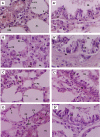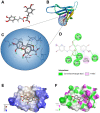Attenuation of ovalbumin-induced inflammation and lung oxidative injury in asthmatic rats by Zingiber officinale extract: combined in silico and in vivo study on antioxidant potential, STAT6 and TNF- α pathways
- PMID: 35910291
- PMCID: PMC9325939
- DOI: 10.1007/s13205-022-03249-5
Attenuation of ovalbumin-induced inflammation and lung oxidative injury in asthmatic rats by Zingiber officinale extract: combined in silico and in vivo study on antioxidant potential, STAT6 and TNF- α pathways
Abstract
In the present study we focused on the anti-asthmatic and antioxidant effects of Zingiber officinalis roscoe L. (ZO) aqueous extract. This study includes 20 adult male rats, which were grouped into four; Group I: control group; Group II: asthmatic group (Ovalbumin sensitized/challenge model, Oval group); Group III: received ovalbumin sensitized/challenge associated a dose of 207 mg/kg body weight (BW) of ZO (Oval + D1 group); Group IV: received ovalbumin sensitized/challenge associated a dose of 414 mg/k BW of ZO (Oval + D2 group). After 21 days, blood and lung samples were collected for biochemical, hematological, and histopathological analyses. The ameliorative effect of ZO phytochemical compounds was also assessed by in silico approach on transducer and activator of transcription 6 (STAT6) and tumor necrosis factor-α (TNF-α) receptors. The oxidative/antioxidative status was evaluated in the lung tissues. Our results show that ZO extract alleviated the ovalbumin-induced hematological and biochemical disruptions associated oxidative injury. In fact, white and red blood cells (WBC and RBC, respectively), aspartate aminotransaminase (ASAT), malondialdehyde (MDA), glutathione (GSH), and glutathione peroxidase (GPx) were significantly disrupted (p < 0.05) in Oval group and alleviated following ZO treatment. Besides, several histopathological features were outlined in lung tissues of Oval group. Interestingly, ZO was found to exert ameliorative effects on tissue level. In silico analyses, particularly the binding affinities, the number of H-bonds, the embedding distance and the molecular interactions of ZO phytochemical compounds with either STAT6 or TNF-α supported the in vivo results. These findings confirm the potential ethno-pharmacological effects of ZO against asthma and its associated complications.
Keywords: Asthma; Inflammation; Molecular interactions; Ovalbumin; Oxidative damage; Zingiber officinalis roscoe L..
© King Abdulaziz City for Science and Technology 2022, Springer Nature or its licensor holds exclusive rights to this article under a publishing agreement with the author(s) or other rightsholder(s); author self-archiving of the accepted manuscript version of this article is solely governed by the terms of such publishing agreement and applicable law.
Conflict of interest statement
Conflict of interestThe authors declare that they have no conflicts of interest in the publication.
Figures





References
-
- Ade S, Adjibode O, Awanou B, et al. Résultats de la prise en charge de l’asthme persistant sévère dans des conditions de ressources limitées : expérience du Bénin. Rev FrAllerg. 2017;57(3):271. doi: 10.1016/j.reval.2017.02.171. - DOI
LinkOut - more resources
Full Text Sources
Research Materials
Miscellaneous

